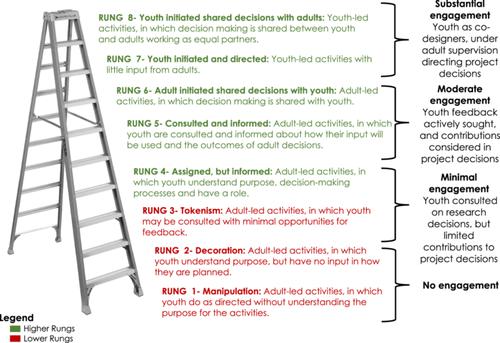Engaging youth in mental health research and intervention design has the potential to improve their relevance and effectiveness. Frameworks like Roger Hart's ladder of participation, Shier's pathways to participation and Lundy's voice and influence model aim to balance power between youth and adults. Hart's Ladder, specifically, is underutilized in global mental health research, presenting new opportunities to examine power dynamics across various contexts. Drawing on Hart's ladder, our study examined youth engagement in mental health research across high- and middle-income countries using Internet-based technologies, evaluating youth involvement in decision-making and presenting research stages that illustrate these engagements.
We conducted a directed content analysis of youth engagement in the study using primary data from project documents, weekly AirTable updates and discussions and interviews with youth and the research consortium. Using Hart's Ladder as a framework, we describe youth engagement along rungs throughout different research stages: cross-cutting research process, onboarding, formative research and quantitative and qualitative study designs.
Youth engagement in the MindKind study fluctuated between Rung 4 (‘Assign, but informed’) and Rung 7 (‘Youth initiated and directed’) on Hart's Ladder. Engagement was minimal in the early project stages as project structures and goals were defined, with some youth feeling that their experiences were underutilized and many decisions being adult-led. Communication challenges and structural constraints, like tight timelines and limited budget, hindered youth engagement in highest ladder rungs. Despite these obstacles, youth engagement increased, particularly in developing recruitment strategies and in shaping data governance models and the qualitative study design. Youth helped refine research tools and protocols, resulting in moderate to substantial engagement in the later research stages.
Our findings emphasize the value of youth–adult partnerships, which offer promise in amplifying voices and nurturing skills, leadership and inclusiveness of young people. Youth engagement in project decision-making progressed from lower to higher rungs on Hart's Ladder over time; however, this was not linear. Effective youth engagement requires dynamic strategies, transparent communication and mutual respect, shaping outcomes that authentically reflect diverse perspectives and mental health experiences.
There was substantial patient and public involvement in this study. This paper reports findings on youth engagement conducted with 35 young people from India, South Africa and the United Kingdom, all of whom had lived experience of mental health challenges. Youth engagement in the MindKind study was coordinated and led by three professional youth advisors (PYAs) in these contexts, who were also young people with lived experience of mental health challenges. Each of the three study sites embedded a full-time, community-based PYA within their study team to inform all aspects of the research project, including the development of informational materials and the facilitation of Young People's Advisory Group (YPAG) sessions referenced in this paper. Each PYA also consulted with a site-specific YPAG that met bi-monthly throughout the project, shaping the formation of study materials and serving as a test group in both the quantitative and qualitative studies. Youth participants in this study also contributed extensively, engaging in data collection and manuscript writing. The following youth advisory panels members (J.B., L.B., D.O.J., M.V.) and all PYAs (E.B., S.R., R.S.) in the MindKind study contributed to the writing of this manuscript and are acknowledged as co-authors.



